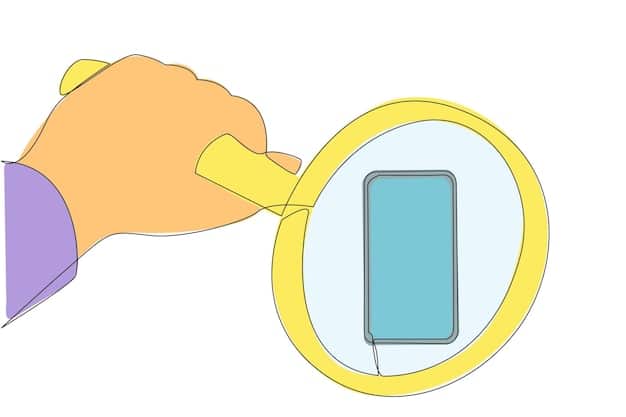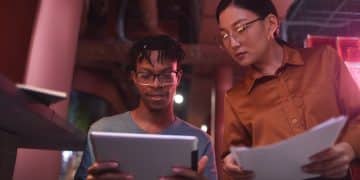Critical Thinking in the Digital Age: Make Informed Decisions

Critical thinking in the digital age involves evaluating information with scrutiny and applying reasoned judgment to make informed decisions amidst the vast amount of online data.
In an era defined by information overload, the ability to think critically has never been more crucial. Critical thinking in the digital age: How to evaluate information and make informed decisions is not just an academic skill; it’s an essential life skill.
Why critical thinking matters in the digital age
The digital landscape is flooded with information, making it challenging to distinguish facts from falsehoods. Developing critical thinking skills can help individuals navigate this complex environment more effectively.
In the digital age, critical thinking is not merely an asset but a necessity. The ability to discern credible sources from unreliable ones, identify biases, and analyze arguments objectively becomes paramount.
Combating misinformation
One of the primary reasons critical thinking matters is its role in combating misinformation. The internet is rife with fake news, conspiracy theories, and propaganda, making it easy for individuals to be misled.
- Fact-checking: Always verify information through multiple reputable sources.
- Source evaluation: Assess the credibility and bias of information sources.
- Emotional awareness: Recognize when emotions might be clouding judgment.
Enhancing decision-making
Critical thinking also enhances decision-making by enabling individuals to approach problems with a rational and analytical mindset. This is crucial in personal, professional, and civic life.
The ability to analyze different perspectives, evaluate evidence, and consider the consequences of each option leads to more informed and effective decisions.

In conclusion, critical thinking is essential for navigating the digital age, combating misinformation, and making informed decisions. By honing these skills, individuals can become more discerning consumers of information and more effective problem-solvers.
Understanding cognitive biases
Cognitive biases are systematic patterns of deviation from norm or rationality in judgment. These biases can significantly impact our ability to think critically and make rational decisions.
In the context of the digital age, cognitive biases are amplified by the ease with which information can be tailored to reinforce pre-existing beliefs.
Common cognitive biases
Several cognitive biases are particularly relevant in the digital age. Understanding these biases helps to identify and mitigate their impact.
- Confirmation bias: Seeking out information that confirms one’s existing beliefs, while ignoring contradictory evidence.
- Anchoring bias: Over-relying on the first piece of information received, even if it is irrelevant or inaccurate.
- Availability heuristic: Overestimating the importance of information that is readily available or easily recalled.
Mitigating cognitive biases
Although cognitive biases are hardwired into the human brain, there are strategies to mitigate their influence on critical thinking.
By actively questioning assumptions, seeking diverse perspectives, and employing structured decision-making processes, one reduces the effects of these biases.
In summary, understanding and mitigating cognitive biases is a crucial aspect of critical thinking in the digital age. Awareness of these biases enables individuals to approach information with greater objectivity and make more rational decisions.
Evaluating sources of information
The digital age has brought an unprecedented amount of information at our fingertips, but not all information is created equal. Evaluating sources is critical for discerning credibility.
Developing the ability to assess the reliability and validity of information sources is essential for critical thinking in the digital age.

Assessing website credibility
When evaluating online sources, several factors can help determine their credibility. These include the website’s domain, author’s credentials, and the presence of citations.
- Domain name: Look for reputable domains like .edu, .org, or .gov, which often indicate authoritative sources.
- Author’s credentials: Check the author’s expertise and affiliations to assess their qualifications.
- Citations: Verify that the information is supported by credible evidence and properly cited sources.
Cross-referencing information
One of the most effective ways to assess the accuracy of information is to cross-reference it with multiple sources. This helps to identify any discrepancies or biases.
If multiple reputable sources present similar information, it is more likely to be accurate. However, if there are conflicting accounts, critical thinking is needed to determine the most reliable version.
In conclusion, evaluating sources is a critical skill for navigating the digital age. By assessing website credibility and cross-referencing information, individuals can make more informed decisions based on reliable data.
Techniques for fact-checking
Fact-checking is verifying the accuracy of factual claims. With the proliferation of fake news and misinformation, fact-checking capabilities are more necessary than ever.
In the digital age, fact-checking is an essential tool for critical thinking, helping individuals separate truth from falsehood.
Using fact-checking websites
Several websites and organizations are dedicated to fact-checking. These resources can be invaluable for verifying the accuracy of information encountered online.
Snopes, PolitiFact, and FactCheck.org are examples of reputable fact-checking websites. These platforms provide detailed analyses of claims, rating them based on their accuracy.
Reverse image search
Reverse image search helps to verify the authenticity and context of images. This technique involves uploading an image to a search engine to find where else it has been used online.
If an image has been misrepresented or taken out of context, a reverse image search can help expose the manipulation. This is particularly useful for identifying fake news stories or propaganda.
In summary, fact-checking techniques are essential for critical thinking in the digital age. By using fact-checking websites and reverse image search, individuals can verify the accuracy of information and avoid being misled.
Developing analytical skills
Analytical skills involve breaking down complex information into smaller parts for examination. Cultivating these skills is crucial for critical thinking.
Analytical skills enable individuals to identify patterns, draw conclusions, and make informed judgments based on evidence.
Identifying logical fallacies
Logical fallacies are flaws in reasoning that render an argument invalid. Recognizing these fallacies is essential for critical analysis.
- Ad hominem: Attacking the person making the argument rather than the argument itself.
- Straw man: Misrepresenting an opponent’s argument to make it easier to attack.
- Bandwagon fallacy: Arguing that something is true because it’s popular.
Constructing logical arguments
In addition to identifying fallacies, developing the ability to construct logical arguments strengthens analytical skills. This involves presenting evidence and drawing well-supported conclusions.
When constructing arguments, use deductive reasoning, moving from general principles to specific instances, or inductive reasoning, moving from specific observations to general conclusions.
In conclusion, developing analytical skills is a critical component of critical thinking in the digital age. By identifying logical fallacies and constructing sound arguments, individuals can improve their ability to analyze information and make informed decisions.
Promoting critical thinking in education
Education plays a vital role in fostering critical thinking skills. Integrating critical thinking into educational curricula helps equip students with the tools they need to navigate the digital age.
By promoting critical thinking in education, institutions prepare students to be informed, discerning citizens and effective problem-solvers.
Integrating critical thinking into curricula
One of the most effective ways to foster critical thinking is to integrate it into educational curricula across all subjects.
This can include activities such as debates, case studies, and research projects that require students to analyze information, evaluate sources, and construct arguments.
Encouraging questioning and debate
Creating a classroom environment that encourages questioning and debate is essential for promoting critical thinking. Students should feel comfortable challenging assumptions and expressing their views.
Teachers can facilitate this by posing open-ended questions, encouraging students to consider multiple perspectives, and fostering a culture of respectful disagreement.
In summary, promoting critical thinking in education is crucial for preparing students to navigate the digital age. By integrating critical thinking into curricula and encouraging questioning and debate, educational institutions can empower students to become informed, discerning citizens.
| Key Point | Brief Description |
|---|---|
| 🔍 Evaluating Sources | Assess credibility using domain names, author credentials, and verifying citations. |
| 🛡️ Combating Biases | Recognize and mitigate cognitive biases by questioning assumptions. |
| ✅ Fact-Checking | Utilize fact-checking websites and reverse image search. |
| 📚 Analytical Skills | Develop skills by identifying logical fallacies and constructing logical arguments. |
Frequently Asked Questions
▼
Critical thinking is the ability to analyze information objectively and make reasoned judgments. It involves evaluating evidence and arguments to form sound conclusions.
▼
In the digital age, individuals are bombarded with information, making it difficult to discern truth. Critical thinking helps to navigate this overload and identify misinformation.
▼
To enhance critical thinking, practice evaluating sources, understanding cognitive biases, and challenging assumptions. Engage in debates and analyze different perspectives regularly.
▼
Cognitive biases are systematic patterns of deviation from norm or rationality in judgment. They can influence decision-making, often leading to inaccurate conclusions.
▼
Education can promote critical thinking by integrating it into curricula, encouraging questioning, and fostering a classroom environment where students feel comfortable expressing their views.
Conclusion
Developing critical thinking skills is essential for navigating the complexities of the digital age. By evaluating information, understanding biases, and promoting critical thinking in education, individuals can make more informed decisions and contribute to a more discerning society.





